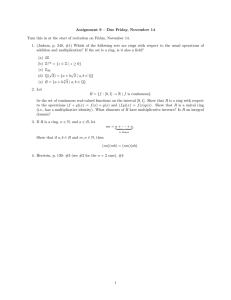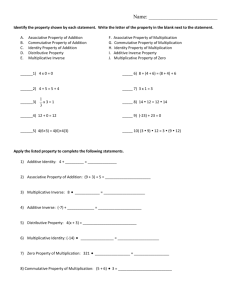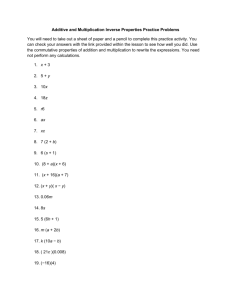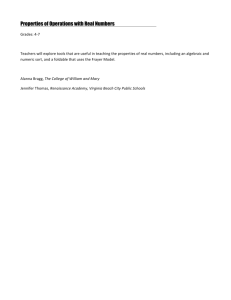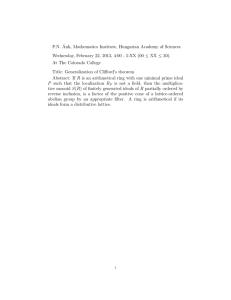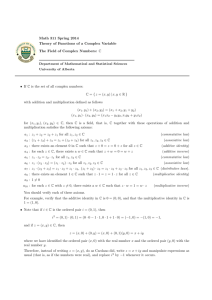Solutions to Assignment 9
advertisement
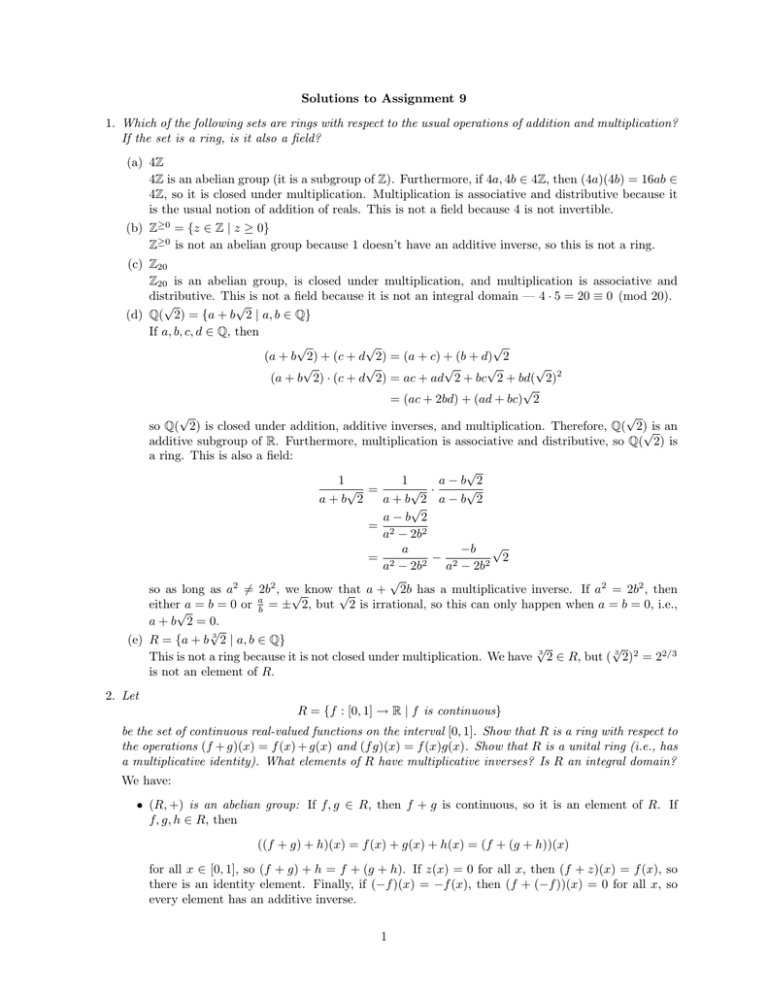
Solutions to Assignment 9
1. Which of the following sets are rings with respect to the usual operations of addition and multiplication?
If the set is a ring, is it also a field?
(a) 4Z
4Z is an abelian group (it is a subgroup of Z). Furthermore, if 4a, 4b ∈ 4Z, then (4a)(4b) = 16ab ∈
4Z, so it is closed under multiplication. Multiplication is associative and distributive because it
is the usual notion of addition of reals. This is not a field because 4 is not invertible.
(b) Z≥0 = {z ∈ Z | z ≥ 0}
Z≥0 is not an abelian group because 1 doesn’t have an additive inverse, so this is not a ring.
(c) Z20
Z20 is an abelian group, is closed under multiplication, and multiplication is associative and
distributive. This is not a field because it is not an integral domain — 4 · 5 = 20 ≡ 0 (mod 20).
√
√
(d) Q( 2) = {a + b 2 | a, b ∈ Q}
If a, b, c, d ∈ Q, then
√
√
√
(a + b 2) + (c + d 2) = (a + c) + (b + d) 2
√
√
√
√
√
(a + b 2) · (c + d 2) = ac + ad 2 + bc 2 + bd( 2)2
√
= (ac + 2bd) + (ad + bc) 2
√
√
so Q( 2) is closed under addition, additive inverses, and multiplication. Therefore, Q( 2)√is an
additive subgroup of R. Furthermore, multiplication is associative and distributive, so Q( 2) is
a ring. This is also a field:
√
1
1
a−b 2
√ =
√ ·
√
a+b 2
a+b 2 a−b 2
√
a−b 2
= 2
a − 2b2
a
−b √
= 2
− 2
2
2
a − 2b
a − 2b2
√
so as long as a2 6= 2b2 , we
know that
a + 2b has a multiplicative inverse. If a2 = 2b2 , then
√
√
either a = b = 0 or ab = ± 2, but 2 is irrational, so this can only happen when a = b = 0, i.e.,
√
a + b 2 = 0.
√
(e) R = {a + b 3 2 | a, b ∈ Q}
√
√
This is not a ring because it is not closed under multiplication. We have 3 2 ∈ R, but ( 3 2)2 = 22/3
is not an element of R.
2. Let
R = {f : [0, 1] → R | f is continuous}
be the set of continuous real-valued functions on the interval [0, 1]. Show that R is a ring with respect to
the operations (f + g)(x) = f (x) + g(x) and (f g)(x) = f (x)g(x). Show that R is a unital ring (i.e., has
a multiplicative identity). What elements of R have multiplicative inverses? Is R an integral domain?
We have:
• (R, +) is an abelian group: If f, g ∈ R, then f + g is continuous, so it is an element of R. If
f, g, h ∈ R, then
((f + g) + h)(x) = f (x) + g(x) + h(x) = (f + (g + h))(x)
for all x ∈ [0, 1], so (f + g) + h = f + (g + h). If z(x) = 0 for all x, then (f + z)(x) = f (x), so
there is an identity element. Finally, if (−f )(x) = −f (x), then (f + (−f ))(x) = 0 for all x, so
every element has an additive inverse.
1
• R is closed under multiplication: If f and g are continuous, then f g is continuous.
• Multiplication is associative: If f, g, h ∈ R, then
((f g)h)(x) = f (x)g(x)h(x) = (f (gh))(x)
• Distributivity: If f, g, h ∈ R, then
((f + g)h)(x) = f (x)h(x) + g(x)h(x) = (f h + gh)(x)
and
(h(f + g))(x) = h(x)f (x) + h(x)g(x) = (hf + hg)(x)
for all x.
Therefore, R is a ring.
It is unital because the constant function 1 is a multiplicative identity. Whenever f (x) is a function
such that f (x) 6= 0 for all x, then (1/f )(x) = 1/f (x) is continuous and f · (1/f ) = 1, so f has a
multiplicative inverse. On the other hand, if f · g = 1, then f (x) 6= 0 for all x ∈ [0, 1], so the invertible
functions are exactly those functions that are never zero.
R is not an integral domain because it has zero-divisors. Let
(
0
x < 1/2
f (x) =
x − 1/2 x ≥ 1/2
and
(
g(x) =
Then
1/2 − x
0
x < 1/2
x ≥ 1/2.
(
0 · (1/2 − x) x < 1/2
(f g)(x) =
= 0,
(x − 1/2) · 0 x ≥ 1/2
but f and g are nonzero.
3. If R is a ring, n ∈ N, and a ∈ R, let
na = a + · · · + a .
| {z }
n times
Show that if a, b ∈ R and m, n ∈ N, then
(na)(mb) = (nm)(ab).
(na)(mb) = (a + · · · + a)(mb)
| {z }
n times
= a(mb) + · · · + a(mb)
{z
}
|
distributive property
= n(a(mb))
definition of na
n times
= n(a(b + · · · + b))
| {z }
m times
= n(ab + · · · + ab)
|
{z
}
distributive property
m times
= ab + · · · + ab
|
{z
}
nm times
= (nm)(ab)
2
4. Herstein, p. 130: #3
For each natural number n, the product (a + b)n is the sum of the 2n products of the form r1 . . . rn ,
where ri = a or ri = b for all i. That is,
X
(a + b)n =
r1 . . . rn .
(1)
r1 ,...,rn ∈{a,b}
We prove this by induction. When n = 1, this is true: (a + b)1 = a + b. Suppose that (1) is true for n.
Then
(a + b)n+1 = (a + b)n (a + b)
X
=
r1 . . . rn (a + b)
r1 ,...,rn ∈{a,b}
X
=
r1 ,...,rn ∈{a,b}
r1 . . . rn b
r1 ,...,rn ∈{a,b}
X
=
X
r1 . . . rn a +
r1 . . . rn+1
r1 ,...,rn+1 ∈{a,b}
as desired.
Herstein, p. 130: #4
First, note that for all x ∈ R, we have
x = x2 = (−x)2 = −x,
so x = −x.
Furthermore, if x, y ∈ R, then
x + y = (x + y)2
x + y = x2 + xy + yx + y 2
x + y = x + xy + yx + y0
= xy + yx.
Therefore, xy = −yx = yx, so R is commutative.
3

